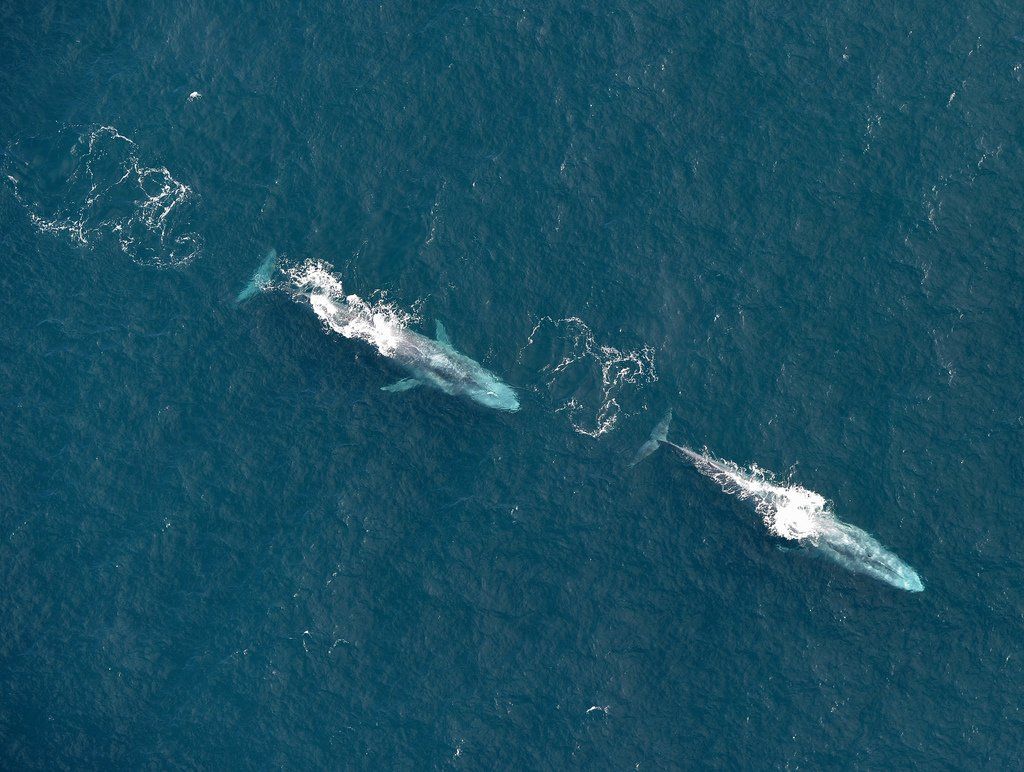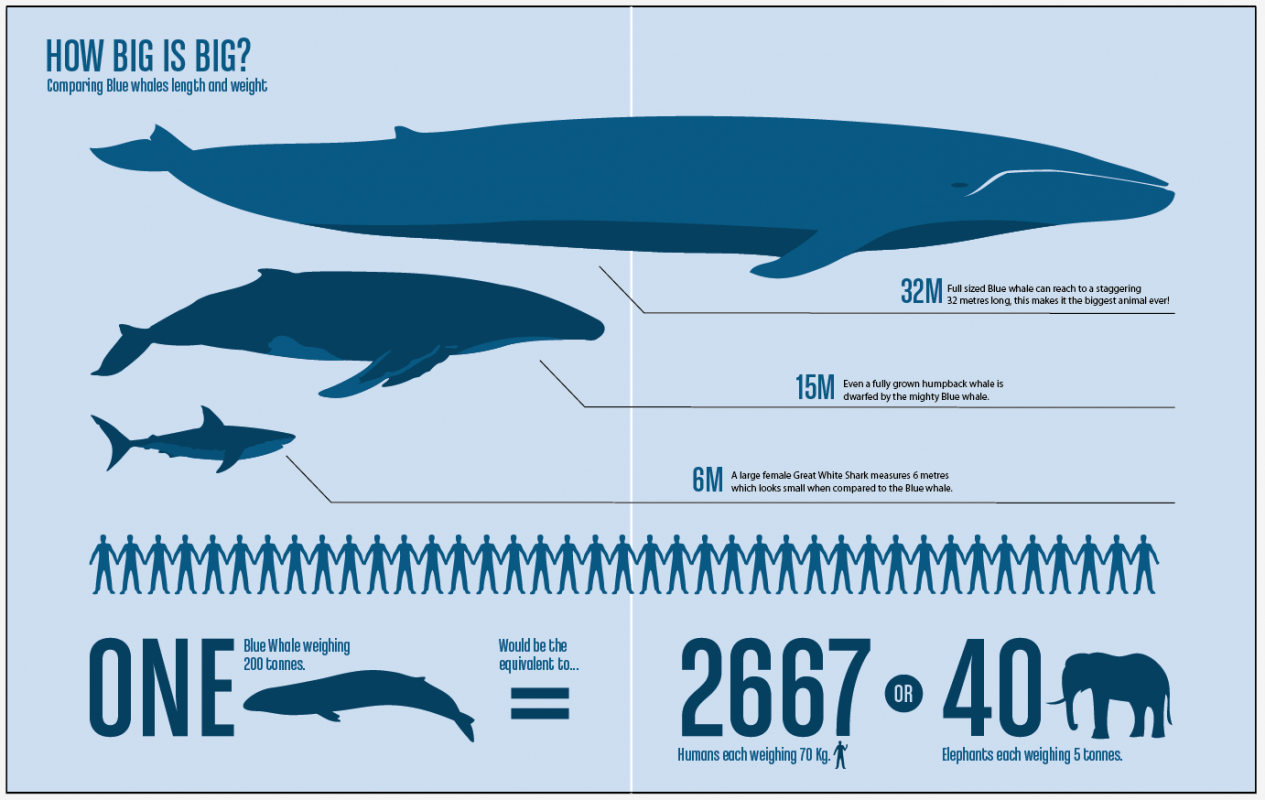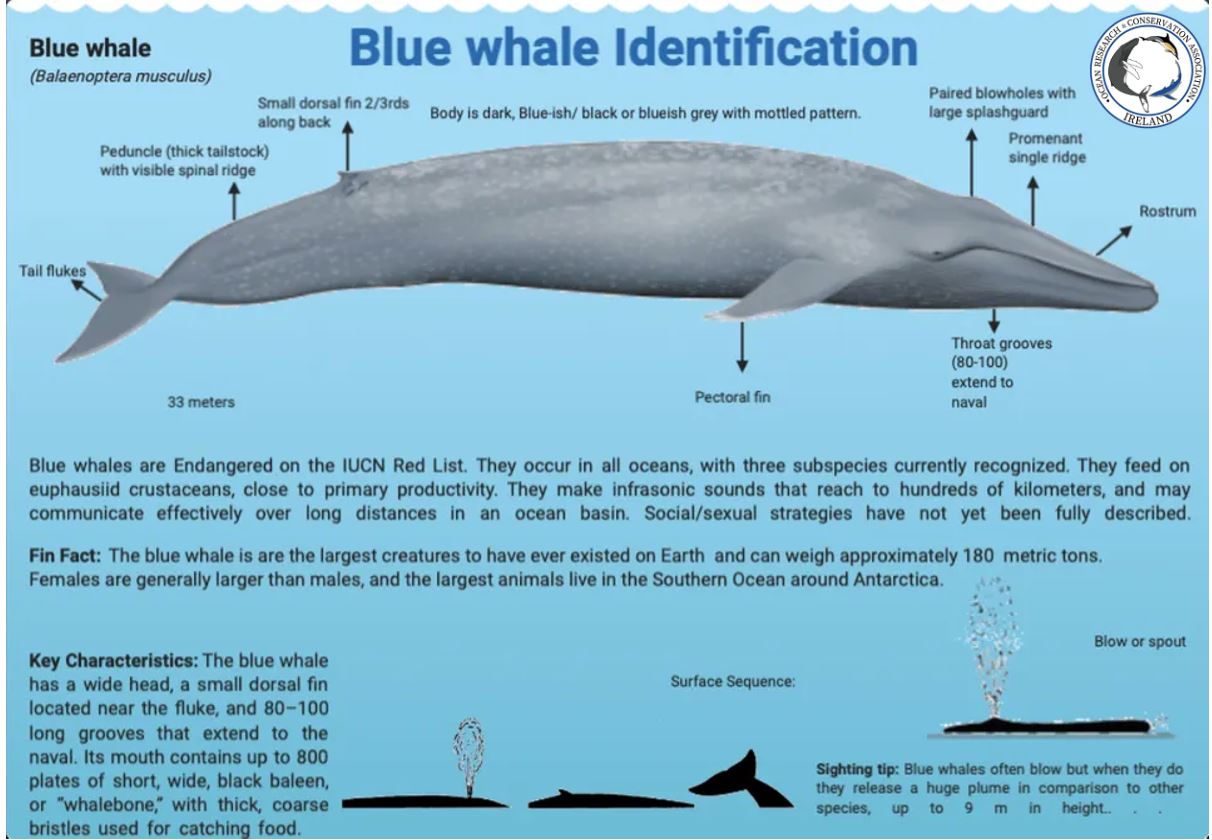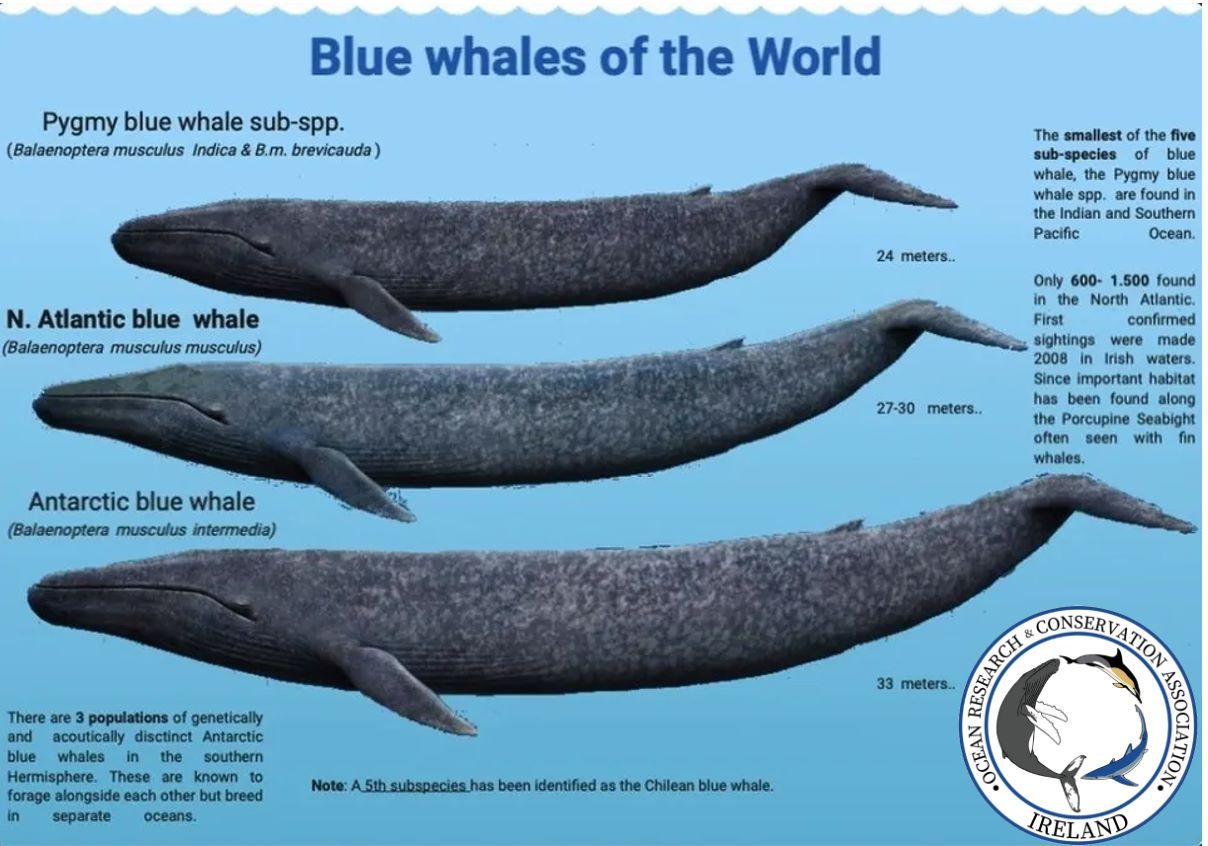Blue whale
(Balaenoptera musculus)
Two blue whales photographed by the Irish Air Corps 80-100 nautical miles off Ireland’s south coast. Source: Irish Defence Forces.
Next Species ---->
Kingdom: Animalia
Phylum: Chordata
Class: Mammalia
Order: Artiodactyla
Infraorder: Cetacea
Family:
Balaenopteridea
Genus: Balaenoptera
Species: B. musculus
Get the facts:
Blue whales are marine mammals belonging to the suborder Mysticete or baleen whales. These are the largest animal to have ever lived on Earth, even larger than the dinosaurs. Blue whales can reach up to 33 meters in length and weigh up to 190 tons! That's the size of an aeroplane, three school buses or forty elephants standing in a row!
Species Identification:
Blue whales can be identified by their distinctive blue-grey mottled skin
(some individuals may have yellow-brown patches caused by diatoms). A blue whale's tall, slender and vertical blow
can also be used as an identifying characteristic which can reach 9 meters
and upwards in height. Blue whales have a very broad, flattened U-shaped head. Their dorsal fins can be variable in shape and size (from triangular to curved) and is small relative to the body, it is positioned so far back on the body that it is not visible until after the whale has re-submerged its head and is about to dive. Therefore, the majority of their back is visible for a long time before their dorsal fin appears while surfacing. Adult blue whales do not breach, but calves have been observed to do so and they often tail fluke on a dive. A blue whale's tail fluke is very broad with straight or slightly concave bottom edge with a slight notch in the middle. The tail fluke can be 1/4 of body length in size.
Similar species:
fin and sei whales can be confused for blue whales, especially from a distance due to the extremely tall blows of all three species. However, the sheer size of the blue whale and the distinctive blue-grey colouration distinguishes them from all other whales.
Diet:
The blue whale diet consists almost exclusively of planktonic euphausiids (krill) although they also feed on other zooplankton such as copepods. Blue whales are rorqual meaning they have pleats under their throat which expands as they feed to engulf huge amounts of tiny prey, and then expel the salt water through their baleen, which acts as a sieve. To feed, blue whales, similar to other rorquals lunge through swarms of krill, sometimes on their sides or back. Most surface feeding likely occurs during the night when krill concentrations rise in the water column. Due to their enormous size blue whales eat up to 4 tons of krill per day. Feeding requires a large energetic demand and results in their range and recovery being constrained to areas with the most food availability. Therefore, most feeding occurs in high latitude regions, where cool temperate waters are highly productive, usually over continental shelf slopes which provide upwellings.
Habitat:
Blue whales can be found in both coastal and pelagic waters, although generally they follow their prey distribution and can found in areas of upwellings such as continental shelf slopes and over seamounts. In Ireland, blue whales have been observed in offshore waters along the continental shelf edge off the south coast of Ireland, in the Porcupine Seabight, Celtic Sea and along the Rockall Trough off the west coast, but have also have been detected acoustically in waters off the west and north-west coast.
Behaviour:
Blue whales surface intervals can range from 10 - 20 seconds and last between 2 - 6 minutes, before they dive for 5 - 20 minutes. Blue whales lunge feed and conduct bottom dives or deep dives of up to > 125 m depth. During feeding lunges of deep dives, active stroking of the fluke occurs during the accent phase of the lunge and feeding occurs at the apex of this ascent. In comparison, the decent of a lunge feeding dive is associated with gliding. During the ascent phase of a dive their heart rates can increase X 2.5. fold. Blue whale dives have been recorded to last for a duration of 7 minutes at 14 m to 16.5 minutes at 176 m depth. Shallow short -duration dives at night have been associated with rest, and are more representative of a less active state.
Social Structure:
Blue whales are solitary marine mammals, often travelling in small groups of 2 - 3 animals or alone. However, blue whales do have complex social interactions. Unlike other cetacean species they are observed in large mating aggregations, but may gather in large groups where good feeding opportunities are available.
Reproduction:
Very little is known about blue whale mating and calving, although a few nursing ground have been identified around the world, for example in the Gulf of California. Blue whales mate during the summer and calves are generally born in the winter after a 10-12 month gestation period, and remain with their mothers for approx. 8 months. During this time spent with their mothers, a calf can double its size, gaining up to 90 kg per day drinking its mothers fat rich milk.
Vocalisations:
Blue whales have sparse distribution which requires them to be able to communicate to one another over vast distances. Their calls are generally infrasonic (17- 20 Hz), and are too low for human ears to hear. They can produce both mating calls and feeding calls.
Lifespan:
With an average estimated lifespan of 70 -90 years, blue whales are some of the oldest living marine mammals known to inhabit the sea.
Blue Whales of the World:
According to the Society for Marine Mammalogy's Committee on Taxonomy: there are five subspecies of blue whale recognised through-out the world; B. m. musculus
in the North Atlantic and North Pacific, B. m. intermedia
in the Southern Ocean, B. m. brevicauda
(the pygmy blue whale) in the Indian Ocean and South Pacific Ocean, B. m. indica
in the Northern Indian Ocean, and B. m. unnamed subsp. in the waters off Chile.
Blue whales are globally distributed and are separated into populations by ocean basin in the
North Atlantic, North Pacific, and Southern Hemisphere. They follow a seasonal migration pattern between summering and wintering areas, but some evidence suggests that individuals remain in certain areas year-round. In the North Atlantic Ocean, their range extends from the subtropics to the Greenland Sea. The extent of knowledge concerning distribution and movement varies with area and migratory routes are not well known but, in general, distribution is driven largely by food requirements. For example, in Irish waters blue whales prefer deep offshore waters where krill is concentrated.
According to the National Oceanic and Atmospheric Administration’s National Marine Fisheries Services some of these blue whale subspecies have been further divided, resulting in at least nine recognised management units, based largely on unique song types.
Population Status:
The global blue whale population abundance is estimated to be 10,000 to 25,000 animals, roughly 3- 11% of the population size estimated in 1911, before commercial whaling nearly drove the species to extinction. Globally the species is listed as
Endangered on the IUCN Red List, under Appendix 1 on the Convention for Migratory Species CMS. The Antarctic subspecies is listed as
Critically Endangered as the current population estimate is only 1% its pre whaling size. Pygmy blue whales are considered data deficient on the IUCN Red List, and the Northern Indian Ocean blue whales have not been separately assessed, so is also considered data deficient.
Threats to Survival:
A number of human induced threats to the survival of blue whales exist around the world. These include entanglement in fishing gear, ship strike, habitat loss due to pollution from plastic and noise and climate change. Whales can become entangled in fishing gear by being wrapped up in nets and/or fishing line which can be around their tail, mouth or another body part such as their flippers or pectoral fins. Discarded fishing nets and ropes may float at sea for decades or become snagged on rocks or other floating debris. Once entangled in fishing gear, the whale may face an antagonising death, pulling the gear along as it swims for days, weeks, months or even years, while it cuts away at their flesh, before they become too tired, sick and injured or eventually die. For the lucky whales that manage to break free of the fishing gear, they often bare the scars from the entanglement they escaped.
Ship strike poses a major threat to blue whales, especially in areas where their habitat overlaps with shipping lanes as it does off the coast of California and Sri Lanka. Commercial exploitation of krill and and climate change affecting the distribution of krill in various ocean basins could also negatively impact blue whales.








